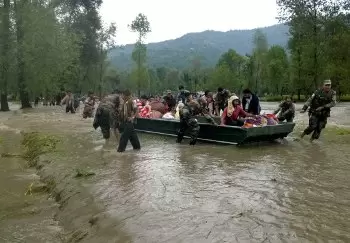Too much of development in Jhelum’s flood basin led to the river’s fury
29-September-2014
Vol 5 | Issue 39
How quickly will Kashmir recover from the shock and trauma this land of meadows, lakes and rivers underwent during the recent floods? Financially, within a few months or years, but emotionally, perhaps never.
For years, there had been warnings that no matter how much the greed and need of humankind to encroach and vandalise rivers, lakes and forests, one day these ecosystems would reclaim their original borders.
 |
|
Some of the flooded areas were at one time Jhelum's flood basin (Photo: Indian Photo Agency)
|
This was ironically ignored by Kashmiris to their own detriment.
Going by historical records, except for its expansion in the north towards Ganderbal and some highlands in the central Badgam districts, the entire growth of summer capital Srinagar through residential colonies, business centres and even government infrastructure creation has for over 130 years been in the flood basin of the Jhelum river that flows through the city.
Historical records, including revenue records of the state government, prove that densely-populated and upscale residential areas left of the Jhelum are its old flood basin.
Walter Lawrence, the British land revenue settlement commissioner of Dogra maharaja Pratap Singh, noted that this huge flood basin had taken the brunt of the 1893 deluge and formed a huge lake right up to the present central Kashmir's Badgam district.
Today, Walter Lawrence's flood basin has vanished. Instead, there are residential neighbourhoods of the rich of Rajbagh, Kursoo, Jawahar Nagar, Gogjibagh, Wazir Bagh, Chanapora, Natipora, Bemina and Qamarwari, among others.
"What can be a bigger proof of the government's lack of foresight and planning than the fact that the Hajj House, the Jhelum Valley Medical College, the state motor garages and even the land records office that houses Kashmir's entire revenue records were constructed by the government in Bemina in the flood basin zone.
"All these government offices are today submerged under 10 feet of flood water," said Farooq Ahmad, 54, a resident of the Qamarwari residential area, whose home has been under the flood waters for the last 12 days.
"Ironically, the entire flood basin that saved Srinagar in 1893 from greater devastation was vandalised through mindless planning for urbanisation," said Hakim Showkat Ali, a well known hydraulic engineer and a retired chief engineer.
"Most of the swollen waters of the Dal Lake were drained through the 'Nallah Mar' (Serpentine canal) that went round the city and drained all its surplus waters into the Jhelum.
"Not only has the majority of Dal Lake's original area been encroached upon over the years, but some of our 'visionary politicians and town planners' in the mid-1960s chose to fill up the 'Nallah Mar', which is today a wide road going around the entire old Srinagar city with shops and houses around it.
"This has been the reason that the present flood inundated some areas due to the choking of water drainage systems because of the swollen Dal Lake," Showkat Ali added.
Ironically, Showkat Ali's house in Srinagar was also inundated by flood waters and he and his wife were rescued by a private boat. His brother, who lived next door, could not be rescued for four days.
Kashmir was called the "Venice of Asia" because of the serpentine Nallah Mar. Most navigation and trade transport of Srinagar was done through this canal.
Today the Dal Lake has swollen in anger to reclaim its original boundaries. The Jhelum, in fury, has again demarcated its flood basin, sending out a devastating warning to Kashmiris not to mess with its majesty.
The mud and slush that the Lidder stream in the south and the Sindh stream in the north brought down with their flood waters to drain into the mighty Jhelum announced loudly and violently that forests in the catchment areas of these streams have been felled, making the soil loose and erosion-prone.
The flood of 2014 has claimed over 200 human lives and billions of rupees in terms of damage to private property, businesses and government infrastructure.
Would this angry warning by nature to Kashmiris not to mess with her lakes, rivers, forests and flood basins be taken seriously so that a greater warning is not needed to jolt them out of their greed?
Well, the future generations would know. One can only hope they don't have to pay for the follies of their forefathers. - IANS















